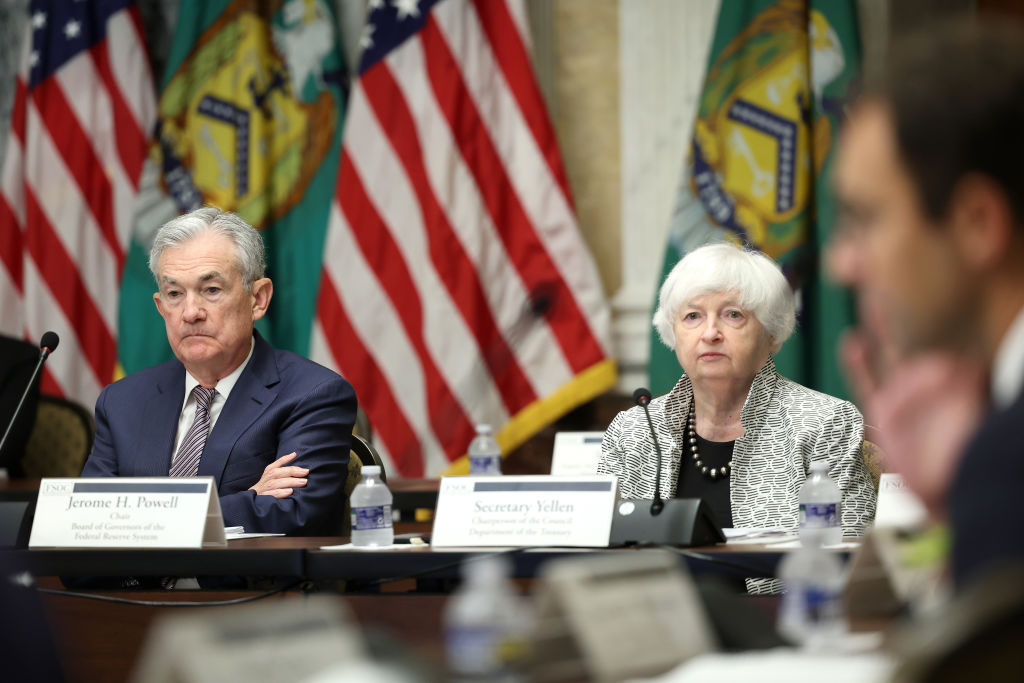Meet New York Community Bancorp.
As the first anniversary of the banking meltdown looms, the US is on the brink of experiencing another bank failure. This time, meet New York Community Bank, a regional institution proving that the challenges that gripped the financial system in March 2023 have yet to vanish. Could the nation witness the downfall of another entity? The coming month will prove to be vital.
Another Bank Failure on the Horizon

Since January 30, New York Community Bank (NYCB) shares have cratered 53% to below $5. The company was slapped with three credit downgrades in about a week. Fitch slashed the firm’s investment grade rating to its lowest ever, Moody’s trimmed the organization’s rating to “junk” status, and Morningstar DBRS hit the downgrade button due to NYCB’s immense commercial real estate market exposure.
Experts think NYCB could endure a repeat of what happened nearly a year ago: Clients take the money and run. So far, liquidity has been decent enough after reports suggested the bank did not suffer any severe deposit outflows. However, with the stock tanking and business media reporting on the company daily, market analysts caution against “the adverse headline risk.”
But rather than be concerned about what graces the pages of The Wall Street Journal or CNBC chyrons, the company’s books should make investors lose sleep at night.
NYCB’s issues started when the company posted a surprise loss, announced a dividend reduction to bolster reserves, and revealed exceptional exposure to the commercial real estate sector. Moreover, more than a quarter of the $83 billion in deposits are uninsured, potentially creating another headache similar to what occurred close to 12 months ago.
The management team attempted to douse the flames by announcing that it would think about selling CRE portfolio loans or allow them to run off the balance sheet naturally. Additionally, Securities and Exchange Commission (SEC) regulatory filings confirmed that NYCB executives purchased approximately $850,000 in stock as part of efforts to signal internal confidence to the broader market.
In the meantime, the bank’s new executive chairman, Alessandro DiNello, attempted to assuage investors’ concerns about another bank failure, saying in a February 7 call:
“The challenge today is not easy. But this company has a strong foundation, strong liquidity, and a strong deposit base, which gives me confidence for our path forward. Overall deposits are up from around 2023, as all areas of the company have performed strongly, including our private banking and mortgage teams. We are already in a strong liquidity position, and we are committed to building liquidity further.”
The business’ troubles led to a selloff in the KBW Nasdaq Regional Banking Index (KRX), an investment fund that reflects the performance of US regional banks. The exchange-traded fund (ETF) has slumped about 10% since January 30 to below $100, though it rebounded during the February 9 session. It still has not recovered from last year’s meltdown when it traded at around $120 and cratered to $77.
Bailouts and Chill
The $2.7 trillion commercial real estate market has returned to the forefront of economic discussions. After widespread reporting on the subject, it faded into the background. However, Treasury Secretary Janet Yellen and Federal Reserve Chair Jerome Powell were asked about this corner of the property sector.

(Photo by Kevin Dietsch/Getty Images)
The former warned at a Senate Banking Committee hearing on February 8 that “it’s obvious there’s going to be stress and losses that are associated with this,” although she thinks the system will manage the possible turbulence. The latter called it a “manageable” problem for the broader sector but conceded that “there’s some smaller and regional banks that have concentrated exposures in these areas that are challenged.” The Eccles Building kingpin dismissed concerns of repeating 2008, but he anticipated that “there will be some banks that have to be closed or merged out of existence because of this.”
Why not just bail out NYCB or the plethora of other institutions? If the White House, the Federal Deposit Insurance Corporation, and the Fed intervened to rescue wealthy depositors at Silicon Valley Bank or Signature Bank, why not do the same for these entities? Perhaps officials are hoping that another bank failure will occur before March 11. This is the scheduled date that the Bank Term Funding Program (BTFP), the central bank’s emergency lending facility launched in the fallout of the banking crisis, will officially expire. Of course, this should not stop the financial regulators as they will likely come up with another scheme to ensure the public really thinks that the banking system is safe, sound, resilient, and highly liquid. In fact, if you say this three times – safe, sound, resilient, and highly liquid – in front of a mirror, you might even receive a bailout right from the printing press.

